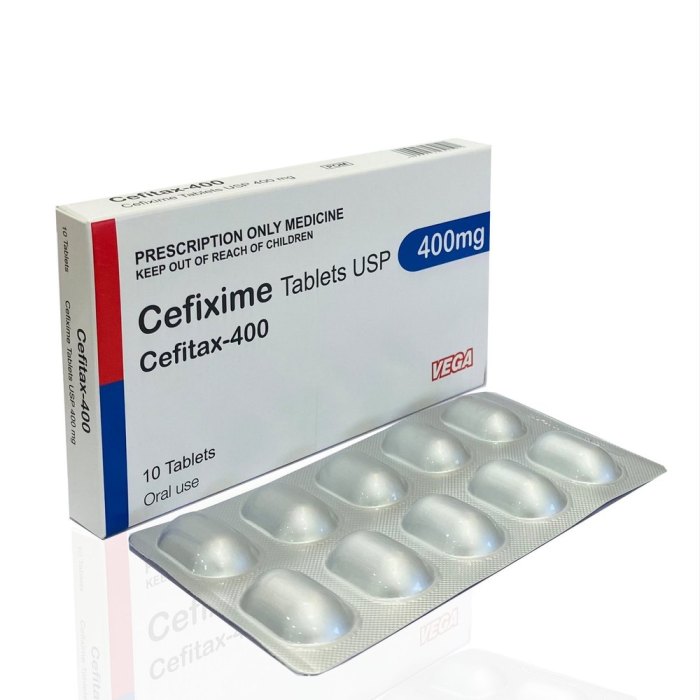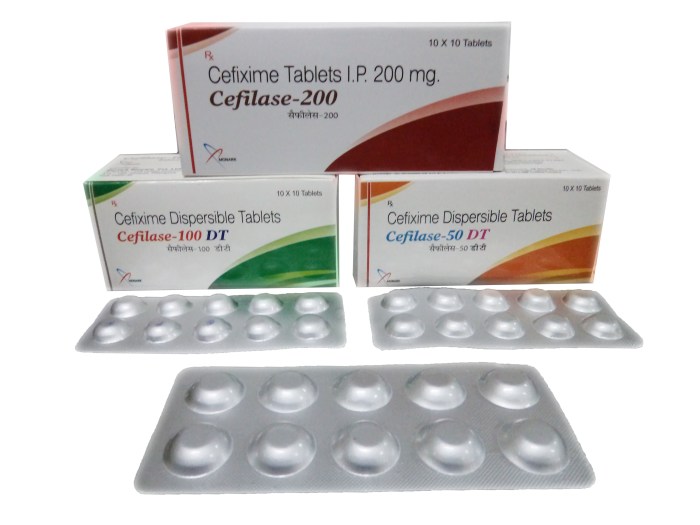Cefixime tablets, a common antibiotic, are prescribed to treat a range of bacterial infections. These tablets are effective against various bacteria, including those responsible for respiratory, urinary tract, and skin infections. Their mechanism of action involves interfering with the bacterial cell wall synthesis, effectively stopping bacterial growth and preventing infection.
Understanding the uses, dosage, and potential side effects of cefixime tablets is crucial for patients and healthcare professionals alike. This information empowers individuals to make informed decisions regarding their treatment and manage potential complications.
Contraindications and Precautions
Cefixime tablets, like any medication, have certain contraindications and precautions that should be considered before administration. Understanding these factors is crucial for ensuring safe and effective treatment.
Contraindications
Cefixime tablets are contraindicated in individuals with a known hypersensitivity to cefixime or other cephalosporin antibiotics. This means that people who have experienced allergic reactions to these medications in the past should avoid cefixime.
Precautions
Patients with Renal Impairment
Cefixime is primarily eliminated through the kidneys. Therefore, patients with renal impairment may require dosage adjustments to prevent drug accumulation and potential toxicity. Careful monitoring of renal function is essential in these individuals.
Patients with Liver Impairment
While cefixime is not metabolized by the liver, it is important to exercise caution in patients with liver impairment as they may have reduced clearance of the drug. Monitoring liver function is recommended during treatment.
Patients with Gastrointestinal Conditions
Cefixime can cause gastrointestinal disturbances, including diarrhea, nausea, and vomiting. It is important to use cefixime with caution in patients with pre-existing gastrointestinal conditions, such as inflammatory bowel disease or ulcerative colitis.
Patients with Seizures
Cefixime, like other cephalosporins, may increase the risk of seizures in susceptible individuals. It should be used with caution in patients with a history of seizures or predisposing factors.
Pregnancy and Breastfeeding
Cefixime is classified as pregnancy category B, indicating that studies in animals have not shown a risk to the fetus, but there are no adequate and well-controlled studies in pregnant women. Cefixime is also excreted in breast milk. Therefore, it is important to weigh the potential benefits against the potential risks before using cefixime during pregnancy or breastfeeding.
Resistance and Stewardship: Cefixime Tablets

The emergence of bacterial resistance to antibiotics is a significant public health concern, posing a threat to effective treatment of infections. Cefixime, like other antibiotics, is susceptible to the development of resistance, which can compromise its efficacy and lead to treatment failures. This section will discuss the importance of antimicrobial stewardship in preventing resistance development and provide recommendations for responsible use of cefixime tablets.
Antimicrobial Stewardship, Cefixime tablets
Antimicrobial stewardship is a coordinated program that promotes the appropriate use of antibiotics to preserve their effectiveness and minimize the emergence of resistance. Key components of antimicrobial stewardship include:
- Monitoring antibiotic use patterns
- Educating healthcare providers about appropriate antibiotic selection and dosing
- Promoting the use of narrow-spectrum antibiotics when possible
- Implementing guidelines for the prevention and treatment of infections
- Evaluating the effectiveness of antimicrobial stewardship programs
Research and Development
Cefixime, a third-generation cephalosporin antibiotic, has been a mainstay in treating various bacterial infections. However, ongoing research efforts are continuously exploring new avenues to enhance its efficacy and safety.
Ongoing Research Efforts
Ongoing research efforts are focused on various aspects of cefixime, including:
- Optimizing Dosing Regimens: Research is underway to determine the most effective dosing regimens for different types of infections and patient populations. This includes investigating the optimal dosage, frequency, and duration of treatment to maximize therapeutic efficacy while minimizing potential side effects.
- Investigating New Formulations: Scientists are exploring new formulations of cefixime, such as extended-release or targeted delivery systems, to improve its bioavailability, reduce dosing frequency, and enhance patient compliance.
- Combating Antibiotic Resistance: Antibiotic resistance is a growing global concern, and researchers are actively working to develop strategies to counter the emergence of cefixime-resistant bacteria. This involves investigating new drug combinations, exploring novel drug targets, and developing resistance-modifying agents.
Potential New Applications
Cefixime’s potential applications are being investigated in various fields, including:
- Treatment of Chronic Infections: Researchers are exploring the use of cefixime in the long-term management of chronic bacterial infections, such as those affecting the respiratory tract, urinary tract, or skin.
- Prophylaxis of Infections: Cefixime’s potential as a prophylactic agent for preventing infections in high-risk individuals, such as those undergoing surgery or with weakened immune systems, is being investigated.
- Treatment of Infections in Special Populations: Research is underway to evaluate the safety and efficacy of cefixime in treating infections in specific populations, such as children, pregnant women, and the elderly.
Future Direction of Research
The future of cefixime research holds promising possibilities.
- Personalized Medicine: Advances in genomics and personalized medicine may enable the development of tailored cefixime therapies based on individual patient characteristics, such as genetic makeup and specific infection types. This could lead to more effective and targeted treatments with reduced side effects.
- Combination Therapies: Exploring combination therapies involving cefixime with other antibiotics or adjunctive therapies may offer synergistic effects and broaden its therapeutic potential.
- Nanotechnology Applications: Nanotechnology could be used to develop novel cefixime delivery systems, such as nanoparticles or liposomes, to enhance drug penetration, target specific tissues, and improve drug efficacy.
Patient Education

This leaflet provides important information about cefixime tablets, a medication used to treat bacterial infections. Please read it carefully before you start taking cefixime and keep it for future reference.
How to Take Cefixime Tablets
Cefixime tablets are usually taken once a day, with or without food. Swallow the tablets whole with a glass of water. Do not crush, chew, or break the tablets.
Dosage
The dosage of cefixime will depend on your specific infection and your doctor’s instructions. It is important to take the correct dosage of cefixime as prescribed.
Side Effects
Like all medicines, cefixime can cause side effects, although not everyone gets them. The most common side effects are:
- Diarrhea
- Nausea
- Vomiting
- Abdominal pain
- Headache
If you experience any of these side effects, they are usually mild and go away on their own. If they bother you or persist, contact your doctor.
Drug Interactions
Cefixime can interact with other medications, so it is important to tell your doctor about all the medications you are taking, including over-the-counter medications, vitamins, and herbal supplements.
Important Information
- Do not take cefixime if you are allergic to cefixime or any other cephalosporin antibiotics.
- If you have kidney problems, tell your doctor before taking cefixime.
- If you are pregnant or breastfeeding, talk to your doctor before taking cefixime.
- Do not take cefixime if you are taking probenecid, a medication used to treat gout.
- It is important to complete the full course of treatment, even if you start to feel better. Stopping the medication early can lead to the infection returning.
Missed Dose
If you miss a dose of cefixime, take it as soon as you remember. However, if it is almost time for your next dose, skip the missed dose and take your next dose at the regular time. Do not take a double dose to make up for a missed dose.
Storage
Store cefixime tablets at room temperature, away from light and moisture. Keep them out of reach of children.
Overdose
If you think you have taken too much cefixime, contact your doctor or local poison control center immediately.
Cefixime tablets remain a valuable tool in combating bacterial infections. However, the emergence of bacterial resistance underscores the importance of responsible antibiotic use. Understanding the potential risks and benefits of cefixime tablets, coupled with appropriate medical guidance, is essential for maximizing treatment effectiveness and minimizing adverse effects.
Ceftriaxone tablets are a type of antibiotic used to treat bacterial infections. While they are generally safe and effective, it’s important to be aware of potential side effects. If you’re also taking a medication like Farxiga, it’s crucial to be informed about its potential side effects as well, such as dehydration and urinary tract infections. Learn more about Farxiga side effects here.
Always consult with your doctor or pharmacist about any concerns you have regarding medication interactions or potential side effects, ensuring the safe and effective use of cefixime tablets.